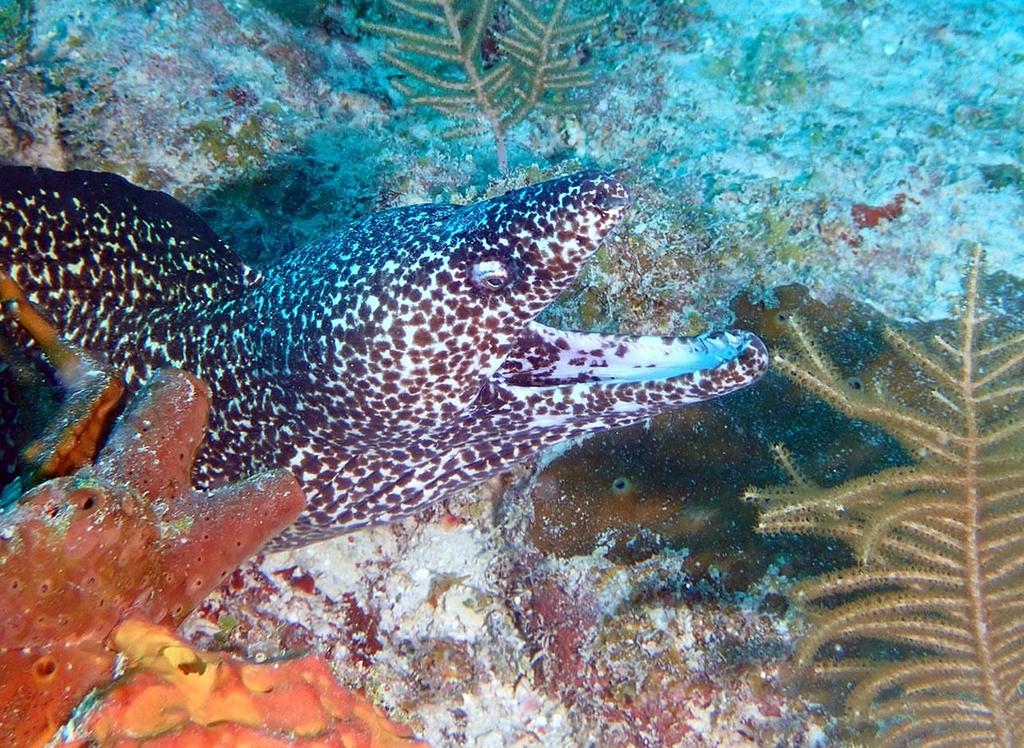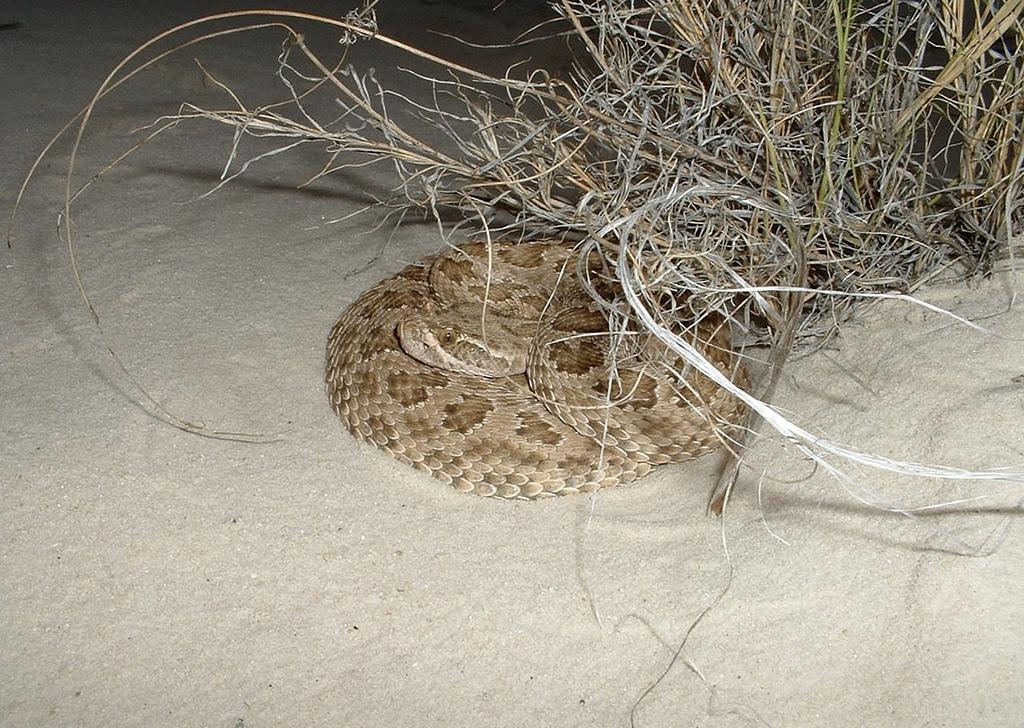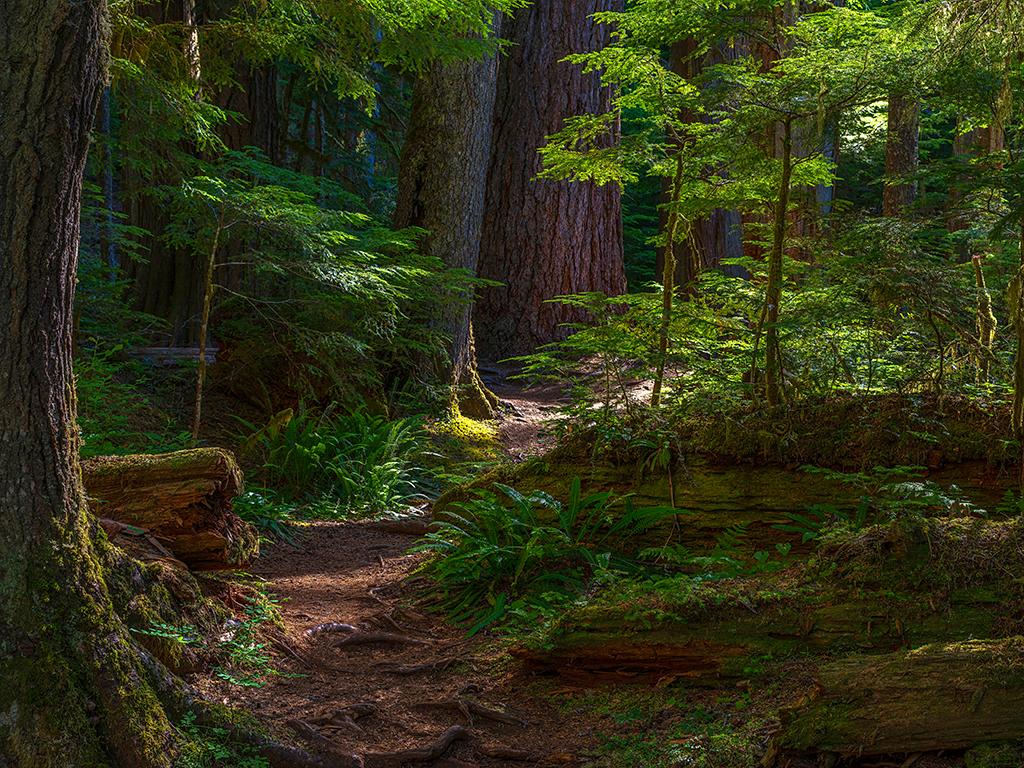
Shaking off that excess water, Glacier National Park / Rebecca Latson file
National Park Service Instagram and Facebook accounts, along with other reliable websites, provide so much quiz-and-trivia-worthy information that I know I will never be wanting for questions and facts for these quiz and trivia pieces. So, without further ado, read on to see how much you really know about sights, sounds, and history within units of the National Park System before checking the answers at the bottom of the page. You might surprise yourself with your knowledge and you’ll definitely learn something new.
1. Visit Fishercap Lake in the Many Glacier Area of Glacier National Park in Montana, and you are almost certain to spot a moose. True or False: moose can move both their eyes and ears independently of one another.
a) True
b) False

Black-and-white spotted eel, Biscayne National Park / NPS file
2. Take a dive at Biscayne National Park in Florida and you might see a spotted moray eel. True or False: moray eels, unlike other eels, do not have dorsal fins.
a) True
b) False

American dipper with a fish egg snack, North Cascades National Park / NPS - Chris Williams
3. Visit a national park like Yellowstone or North Cascades and you’ll likely see a funny little bird standing in shallow streams. The American dipper is also known as a ___.
a) Water ouzel
b) Water skipper
c) Stream skimmer
d) Diver bird

This helped Civil War-era surgeons to locate an embedded bullet, Fort Larned National Historic Site / NPS - Ben Long
4. If you were an injured soldier at Fort Larned in Kansas, and a surgeon was trying to remove a bullet from you, he might first prod around the outside of the wound with his fingers, trying to locate the embedded bullet. If that didn’t work, the surgeon would then insert into the injured area a metal probe known as a ___ to attempt to locate the bullet.
a) Toucher
b) Feeler
c) Sound
d) Bullet mover

A wildlife cam image of a unicorn - er - elk with only one antler, Petrified Forest National Park / NPS file
5. Elk live, roam, and graze within many units of the National Park System, including Yellowstone, Petrified Forest, Rocky Mountain, Olympic, and Great Smoky Mountains national parks. Elks shed their antlers, usually in late winter or early spring. However, elk can lose their antlers in other ways, including sparring, poor nutrition, or ___.
a) Microbial bacteria in water
b) Rubbing too much against a hard surface like a tree
c) Using antlers for digging
d) Decreasing daylight

A blooming hedgehog cactus, Organ Pipe Cactus National Monument / NPS file
6. Organ Pipe Cactus National Monument in Arizona is home to over 28 species of cacti, of which there are ___ species of “hedgehog” cacti.
a) Two
b) Three
c) Four
d) Five

Sleeping, or awake? White Sands National Park / NPS file
7. So many park units are home to all sorts of snakes. True or False: snakes do not sleep.
a) True
b) False

A spittlebug bubble fortress / USFWS file
8. Perhaps you have gone hiking in Apostle Islands National Lakeshore in Wisconsin and come across plants that look like they are covered in foamy spit. This “spit” comes from the spittlebug, also known as the ___.
a) Flower flipper
b) Foam frother
c) Froghopper
d) Leafpopper

Sun and shadow in the forest interior, Mount Rainier National Park / Rebecca Latson file
9. According to the staff at Mount Rainier National Park in Washington state, “The forests of the Pacific Northwest tend to be rather dark, especially at this time of the year, and it is that very absence of light which makes the understory [of the forest] so singular. Rich in ferns and mosses, the deep woods host a rich variety of ___ species, i.e., those vascular plants which, although requiring light to initiate the photosynthetic processes, nevertheless cannot endure it for protracted periods.”
a) Sun-fleck
b) Dappled-light
c) Sun-speck
d) Sun-and-shadow

Awww. A little fawn spotted (literally) on Bodie Island, Cape Hatteras National Seashore / NPS - P. Doshkov
10. This little deer was spotted foraging on Bodie Island at Cape Hatteras National Seashore. It’s looks make it a ___ deer.
a) Leucistic
b) Appaloosa
c) Piebald
d) Brindle
Trivia

Shaw's Agave in bloom, Cabrillo National Monument / NPS - B. Carmona
Visit Cabrillo National Monument in California and you might have arrived at the right time of year to see Shaw’s Agave (Agave shawii) producing some brilliant, bright, yellow flowers. These flowers attract a variety of pollinators: hummingbirds, insects, and bats. According to the NPS, “The Mexican long-tongued bat (Choeronycteris Mexicana) is usually the natural pollinator of the Shaw’s Agave plant.”
“Shaw’s Agave is a species of concern that is literally and figuratively on the edge along the Southern California coast. It is in the northernmost part of its range in San Diego, where one of the last native populations occurs on the Point Loma Peninsula. It occupies the rare coastal sage scrub community near the boundaries of Cabrillo National Monument. Plants are sometimes found at the edges of eroding sea cliffs.”

Image of a bitterroot flower, Lewis and Clark National Historic Trail / NPS via Curtis American Botanical 1836 via Public Domain
While traveling the route of the Lewis and Clark National Historic Trail, you might come across the lovely pink-purple blooms of a bitterroot plant. "The original people of Montana used the root as an important part of their diet, despite its bitter taste, but cooking the root removes most or all of the bitterness and improves the flavor. Berries or meat are often cooked with it. When boiled, bitterroot swells to about six times its normal size and can be eaten after boiling, or redried and ground into a fine powder for use in other dishes.”
According to the U.S. Forest Service, “Meriwether Lewis first collected the species for western science in July of 1806, in what is now called the Bitterroot Valley in Montana. George Drouillard, a hunter and interpreter on the Lewis & Clark Expedition, had brought the plant to his attention the previous fall after Drouillard had a run-in with some Shoshone who left him in possession of some of their belongings. The woven bags included dried roots of three species, one of which came to be called racine amer by the French trappers, meaning ‘bitter root’.”

Cave explorer Jim White with a kerosene lamp in his hand, Carlsbad Caverns National Park / NPS
Before any genuine headlamp was invented with which to explore what is now Carlsbad Caverns National Park in New Mexico, kerosene lamps were used. According to the NPS, “These ‘lamps’ were made using tin cans filled with kerosene and fitted with a wick made from cloth. They were small and portable, making them ideal for exploring the rugged and uneven terrain of the cave system.” While these kerosene lamps were a step above biofuel torches, their “flames were small and their light was dim, making navigating through the dark cave passages difficult.” Later technological advances led to the invention of the carbide lamp, providing a “brighter, more reliable light source.”
Quiz Answers
1a True
Moose can move each ear and each eye independently of each other. They can also close their nostrils when grazing for tasty greens beneath the water.
2b False
Moray eels, unlike other eels, do not have pelvic or pectoral fins. Moray eels are also secretive in nature and like to hide themselves within crevices in reefs. They are scavengers and predators, locating their food more by scent than by sight. They are generally not aggressive, but don’t push your luck by sticking your hands into reef crevices and recesses. Moray eel jaws are strong.
3a
The American dipper is also known as a water ouzel, “North America’s only truly aquatic songbird,” according to the NPS. “They’re called dippers because they will bob their bodies up and down continuously while on land … They will dive under the water and walk along the streambed while holding their wings out to have traction against currents. They will mostly dive for aquatic insects and larvae, but they will occasionally eat fish eggs.”
4c
If prodding and feeling the outside of a wound with their fingers to locate a bullet didn’t work, a surgeon might then insert a metal probe called a sound or sounder, to locate the bullet. “One end of the sound was placed in or next to the surgeon’s ear while the other end probed the wound, so that the doctor could hear if the metal probe struck metal or another solid object within the body.”
5d
According to the NPS, “Decreasing daylight can trigger lower testosterone production which causes the connection between the antler and the skull to weaken. On the flip side, antler growth is incredibly fast. In fact, antlers are the fastest ‘bone’ growth in the world. Just a few weeks after an elk sheds its antlers, a new set begins to grow. Elk antlers grow about an inch per day.”
6b
Organ Pipe Cactus National Monument is home to three species of “hedgehog” cacti: the Santa Rita claret-cup, strawberry, and golden hedgehogs (Echincereus coccineus, englemannii, and nicholii respectively).
7b False
Snakes do sleep, but since they don’t have eyelids, snakes sleep with both eyes open! How can this be? Well, according to the NPS, sleep is controlled by the brain and that doesn’t require eyelids. “Once asleep, snakes enter rapid eye movement, or REM, just like humans and other mammals. Some species of snakes are nocturnal and sleep during the day, and others are diurnal and sleep at night. Snakes can also sleep up to 20 hours a day during the winter and after eating a large meal.”
8c
According to the NPS, spittlebugs are also known as “froghoppers.” As nymphs, these little bugs create “bubble homes” from frothy excretions of the plant sap they consume. “These bubbles not only keep them hydrated, but also help them with temperature regulations. The bubble homes serve as clever camouflage, hiding the nymphs from potential predators.”
9a
“Rich in ferns and mosses, the deep woods host a rich variety of sun-fleck species, relying on only fleeting, momentary exposure to sun. Plants like Oxalis (Oxalis oregana) and Pathfinder (Adenocaulon bicolor) would wither under direct rays. Piercing gaps between branches and trunks, shafts of light touch the undergrowth but briefly and then move on, having bestowed their ephemeral gift on those who will make the most of it through their unique genetic adaptations.”
10c
According to the NPS, “Piebaldism is a recessive trait and rare genetic anomaly in whitetail deer that leads to a lack of pigmentation in certain places on the body. Shortened legs, jaws, and skeletal misalignment can also occur in piebald deer, but most are born with symptoms that do not impact their quality of life.


